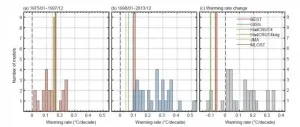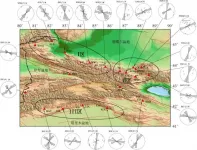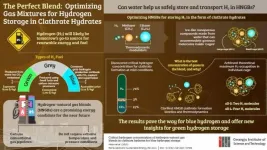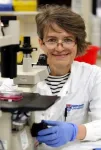Scientists explain why climate models can't reproduce the early-2000s global warming slowdown
2021-05-17
(Press-News.org) A new study led by Dr. Wei and Dr. Qiao from the First Institute of Oceanography, Ministry of Natural Resources provides an evaluation of the performance of the newly released CMIP6 models in simulating the global warming slowdown observed in the early 2000s. This study reveals that the key in simulating and predicting near-term temperate change is to correctly separate and simulate the two distinct signals, i.e., the human-induced long-term warming trend and natural variabilities, especially those at interannual, interdecadal and multidecadal scales. This work was online published in SCIENCE CHINA Earth Sciences on April 15th, 2021.
After the unprecedented warming over the last quarter of the 20th century, the global surface temperature growth slowed unexpectedly during 1998-2013 despite the sharp increase in greenhouse gas emissions; this phenomenon is termed the global warming hiatus or slowdown to be more precise. The global warming slowdown challenges the existing scientific understanding of global temperature change mechanisms, thus has been one of the most concerning issues in recent climate research and even public.
However, the sophisticated and advanced climate models in CMIP5 could not simulate this warming slowdown. During 1998-2013, the models mostly present a rapidly warming surge which greatly deviates from the observed flat temperature time series. The models considerably overestimate the observed warming rate of the recent period. IPCC AR5 stated: "Almost all CMIP5 historical simulations do not reproduce the observed recent warming hiatus". Therefore, the simulation and prediction ability of sophisticated climate models have been questioned.
Now the CMIP6 model data are gradually released since 2020. The newly developed models include better understanding of the global temperature change mechanisms, especially more reasonable physical processes of natural variabilities. Successful simulations of the global warming slowdown are expected in the new-generation models. As the data of 28 new models become available, it is necessary to timely examine the ability of the CMIP6 models on presenting the recent warming slowdown.
By comparison to six widely used global surface temperature datasets, research team from First Institute of Oceanography, Ministry of Natural Resources evaluates the performance of the 28 newly released CMIP6 models in simulating the recent warming slowdown, and finds that most CMIP6 models still fail to reproduce the warming slowdown, although they present some encouraging improvements when compared with CMIP5 models (Figure 1).
Further, they explored the possible reasons for the difficulty of CMIP6 models in simulating the recent warming slowdown. They reveal that it is associated with the models' deficiencies in simulating the distinct temperature change signals from the human-induced long-term warming trend and/or the three crucial natural variabilities at interannual, interdecadal, and multidecadal scales (Figure 2).
This study reveals that the key in simulating and predicting near-term temperate change is to correctly separate and simulate the two distinct signals, i.e., the human-induced long-term warming trend and natural variabilities, especially those at interannual, interdecadal and multidecadal scales. This suggests that the key-scale variabilities require more attention in the models, considering their vital roles in modulating the warming rate change at decadal to multidecadal scales. This result can provide important insight for the simulation and prediction of near-term climate changes.
INFORMATION:
This research was funded by the National Natural Science Foundation of China (Nos. 41806043 & 41821004).
See the article: Wei M, Shu Q, Song Z, Song Y, Yang X, Guo Y, Li X, Qiao F. 2021. Could CMIP6 climate models reproduce the early-2000s global warming slowdown? Science China Earth Sciences, 64, https://doi.org/10.1007/s11430-020-9740-3
[Attachments] See images for this press release:

ELSE PRESS RELEASES FROM THIS DATE:
2021-05-17
The collision between the Indian and Eurasian plates resulted in the formation of the Tianshan Tectonic Belt; however, the formation mechanism of Tianshan and the construction of a dynamic model explaining it remain to be achieved and an integrated understanding has not been reached. A new study adopted shear-wave splitting system to collect and analyze shear-wave splitting parameters of 33 stations in the Tianshan area, it provides new evidence for potentially enhance the understanding the dynamic mechanism of the Tianshan tectonic belt.
The research paper is titled:"Anisotropic zoning in the upper crust of the Tianshan Tectonic Belt, Published in Science China Earth Sciences Issue 4, 2021, Corresponding author ...
2021-05-17
In our ongoing quest to transform into a more eco-friendly society, hydrogen (H2) is heralded as the clean fuel of tomorrow. Because H2 can be produced from water (H2O) without generating carbon emissions, developing H2-compatible technologies has become a top priority. However, the road ahead is bumpy, and many technical limitations must be ironed out. "Hydrogen is the smallest molecule in nature, and finding feasible ways to store it is a critical issue to realize a hydrogen economy," states Associate Professor Youngjune Park from the Gwangju Institute of Science ...
2021-05-17
WASHINGTON, DC--People with cardiovascular disease (CVD) taking aspirin to lower their chances of suffering a heart attack or stroke experienced similar health benefits, including reduced death and hospitalization for heart attack and stroke, whether they took a high or low dose of aspirin, according to a study presented today at ACC.21, the American College of Cardiology's 70th Annual Scientific Session and published in the New England Journal of Medicine.
CVD--and atherosclerosis, in particular, which is a narrowing and hardening of the arteries--is a leading cause of death for men, women, and most racial and ethnic groups in the United States, with estimated direct costs of END ...
2021-05-17
New research has shown that people with type 1 diabetes may have features of premature heart disease induced by the condition often before they even get their diagnosis.
Early markers for this heart disease could be used to ensure patients get targeted therapies as soon as they are diagnosed with type 1 diabetes to slow down or even halt cardiovascular problems.
The findings, published in Stem Cell Research and Therapy, show that tiny pieces of genetic material, called miR-424-5p, increased in early stages of heart disease - these could be targeted to help reduce inflammation in order to compensate for elevated risk.
Early heart disease
Dr Jolanta Weaver, from Newcastle University's Faculty of Medical Sciences, UK, ...
2021-05-17
There's been a breakthrough in the case of the missing planets.
While planet-hunting missions have discovered thousands of worlds orbiting distant stars, there's a severe scarcity of exoplanets that measure between 1.5 and two times Earth's radius. That's the middle ground between rocky super-Earths and larger, gas-shrouded planets called mini-Neptunes. Since discovering this 'radius gap' in 2017, scientists have been sleuthing out why there are so few midsize heavenly bodies.
The new clue arose from a fresh way of looking at the data. A team of researchers led by the Flatiron Institute's Trevor David investigated whether the radius gap changes as planets age. They divvied up exoplanets into two groups -- young and old -- and reassessed the gap. The ...
2021-05-17
The blood thinner apixaban was not superior to standard of care following transcatheter aortic valve replacement (TAVR), according to findings from a new trial called ATLANTIS presented at the American College of Cardiology's 70th Annual Scientific Session. Researchers found that while apixaban reduced the formation of blood clots (thrombosis) around the implanted valve with no increased bleeding risk, a subset of patients taking apixaban who did not have an indication for anticoagulation apart from the TAVR procedure showed a tendency toward a higher rate of non-cardiovascular death--a ...
2021-05-17
Transcatheter left atrial appendage occlusion (LAAO) with a WATCHMAN device was associated with a low rate of stroke at one year even among older patients with atrial fibrillation (AFib) who faced a high risk for stroke or bleeding based on their previous health history, according to new data presented at the American College of Cardiology's 70th Annual Scientific Session.
The WATCHMAN device, which blocks a small portion of the heart to help reduce the risk of a dangerous clot forming, was approved by the U.S. Food and Drug Administration in 2015. The device is used to reduce the risk of stroke in patients with AFib, a heart rhythm disorder, that is not caused by problems with the heart valve. ...
2021-05-17
Patients with an elevated risk of stroke due to heart rhythm problems, or atrial fibrillation (AFib), were much less likely to suffer a stroke after undergoing heart surgery if doctors concurrently performed an additional procedure, called left atrial appendage occlusion (LAAO), according to the results of a trial presented at the American College of Cardiology's 70th Annual Scientific Session.
AFib increases a person's risk of stroke or systemic embolism, which are life-threatening conditions caused by blood clots blocking an artery. It has been hypothesized that the blood clots that cause these conditions often originate in the left atrial appendage, a small sac on the upper left chamber of the heart. LAAO is a procedure to ...
2021-05-17
The heart failure drug sacubitril/valsartan did not significantly reduce the rate of heart failure or cardiovascular death following a heart attack compared to ramipril, an angiotensin converting enzyme (ACE) inhibitor proven effective in improving survival following heart attacks. Findings from the PARADISE-MI trial were presented at the American College of Cardiology's 70th Annual Scientific Session.
The study is the first large trial to examine whether sacubitril/valsartan can reduce heart failure and associated hospitalizations and deaths in patients post-heart attack who face a high risk of developing heart failure. Patients taking sacubitril/valsartan were about 10% less likely than those ...
2021-05-17
Researchers found no significant differences in cardiovascular events or major bleeding in patients with pre-existing cardiovascular disease who were taking 81 milligrams (mg), also called baby aspirin, versus 325 mg of daily aspirin, according to new data presented at the American College of Cardiology's 70th Annual Scientific Session.
Aspirin is the most common medication for people with established cardiovascular disease--for example, those who have had a heart attack, a stent placed or bypass surgery--to help prevent another heart attack, stroke or premature death. But despite aspirin's proven and widespread use, there has been no evidence as to whether low-dose aspirin (81 mg) or regular-strength (325 mg) aspirin is ...
LAST 30 PRESS RELEASES:
[Press-News.org] Scientists explain why climate models can't reproduce the early-2000s global warming slowdown




